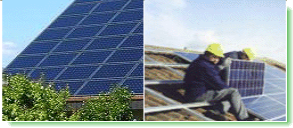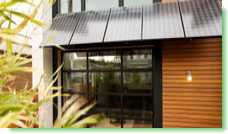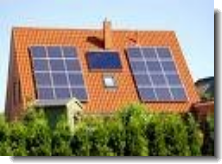eco
design
OUR MISSION
WHO WE ARE
PROJECTS
ECO TECHNOLOGY
CONTACT US
Solar
electricity
WWW. IRISH ECO
ARCHITECTS.COM
M.C.M
Architecture & Surveying Ltd t/a Eco Architects
Ireland © MCM Architects 2009:: Design by NASSY
Eco Architects Ireland - Innovation, Attention
to Detail, Vision, Thinking out of the Box, Expertise.
ECOLOGICAL TECHNOLOGIES
Houses
with Solar Photo Voltaic panels fitted Generate cheap, green electricity
from sunlight
Solar electricity
systems capture the sun's energy using photovoltaic (PV) cells. The cells
convert the sunlight into electricity, which can be used to run household
appliances and lighting.
See how Solar electricity systems work in
practice
PV cells don't need direct sunlight to work - you can still
generate some electricity on a cloudy day.
* How do
photovoltaic (PV) cells work?
* The benefits of solar
electricity
* Is solar electricity suitable for my
home?
* Making the most of solar
electricity
* Costs, savings and maintenance
See
how solar electricity can work along side a heat pump
See how solar
electricity can work along side solar hot water
How do photovoltaic (PV)
cells work?
PV cells are panels you can attach to your roof or walls.
Each cell is made from one or two layers of semiconducting material, usually
silicon. When light shines on the cell it creates an electric field across the
layers. The stronger the sunshine, the more electricity is produced.
PV
cells come in a variety of shapes and colours, from grey "solar tiles" that look
like roof tiles to panels and transparent cells that you can use on
conservatories and glass.
.
The strength
of a PV cell is measured in kilowatt peak (kWp) - that's the amount of energy
the cell generates in full sunlight.
The benefits of solar
electricity
* Cut your carbon footprint: solar
electricity is green, renewables energy ans doesn't release any harmful carbon
dioxide or other pollutants. A typical home PV system could save around 920 kg
of carbon dioxide per year - that's almost 23 tonnes over its
lifetime.
* Cut your electricity bills: sunlight is
free, so once you've paid for the initial installation your electricity costs
will be greatly reduced. A typical home PV system can produce over 40% of the
electricity a household uses in a year.
* Sell
electricity back to the Grid: if your system is producing more electricity than
you need, or when you can't use it, someone else can use it - and you could make
a bit of money. Read more about selling electricity.
*
Store electricity for a cloudy day: if your home isn't connected to the national
grid you can store excess electricity in batteries to use when you need
it.
Is solar electricity suitable for my
home?
Solar panels are not light and your roof must be strong
enough . To tell if solar electricity is right for you, there are a few key
questions to consider:
* Do you have a sunny place
to put it? You'll need a roof or wall that faces within 90 degrees of south, and
isn't overshadowed by trees or buildings. If the surface is in shadow for parts
of the day, your system will generate less energy.
*
Is your roof strong enough? Solar panels are not light and the roof must be
strong enough to take their weight, especially if the panel is placed on top of
existing tiles. If in doubt, ask a construction expert or an
installer.
* Do you need planning permission? , you
don't need planning permission for most home solar electricity systems, as long
as they're below a certain size - but you should check with your local planning
officer if your home is a listed building, or is in a conservation area or World
Heritage Site.
Making the most of solar
electricity
To make electricity you produce go
further:
* invest in energy efficient appliances. Find
energy saving products
* use energy when the sun is out -
do you laundry during the day
to take advantage of
the free electricity
Cost, savings and maintenance
Costs for
installing a solar electricity system vary a lot - an average system costs
between €9,000 and €16,000, depending on its size and type.
In
general:
* the more electricity the system can
generate, the more it
costs but the more it
could save
* solar tiles cost more than conventional
panels
* panels built into a roof are more expensive than
those that sit on top but,
* if you need major roof
repairs, PV tiles can offset the cost of roof tiles
Savings can be
considerable - amost 1 tonne of CO2 a year, and around €210 off your electricity
bill*. A 2 kWp system could provide over 40% of a household's yearly electricity
needs.
Maintenance is generally small - you'll need to keep the panels
relatively clean and make sure trees don't begin to overshadow
them.























